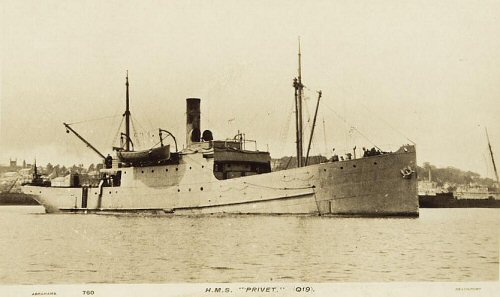
Sold 1919
HMS Privet, completed as the cargo ship Island Queen 1916, taken up as a 'Q' ship 1916-1919 as HMS Privet(Alcala, Island Queen, Q.19, Swisher)-(names in brackets are the disguised identities). Sank U85 and UC29 in 1917 and sank U34 in 1918. Sold in 1919.
On March 12 1917 the British Q-ship HMS Privet avenged the sinking of the T.S.S.California (Anchor Line) and sealed the fate of the crew of the U-85. Posing as an unarmed merchant vessel, the crew of the Privet lured the U-85 to the surface after sustaining heavy damage in an unprovoked attack by the submarine. As the Privetís highly trained crew feigned abandoning ship, they uncovered the shipís massive hidden machine guns and opened fire on the submarine at extremely close range. Perforating the submarine from bow to stern in an unrelenting hail of bullets, they sent U-85, Captain Petz and his crew of 37 men to the bottom of the English Channel; there were no survivors.
In World War I the term " mystery ship " originally referred to a submarine decoy vessel. These ships were developed because of the large loss of shipping caused by German U-boats in the opening months of the war. It did not go unnoticed that the submarines preferred to attack unescorted, older and smaller vessels by using surface gunfire thus preserving their torpedoes for larger vessels or warships and extending their sea cruise durations. Thus it was conceived that a vessel, such as a coaster, if provided with a concealed armament, could meet a surfaced submarine on fairly equal terms. The vessels chosen, code-named Q-ships by the Admiralty and also known as Decoy Vessels and Special Service Ships, were comparatively small, ranging in size from 4,000 tons to small sailing ships, old and made to look poorly maintained. Their outward appearances were indistinguishable from ordinary merchantmen. When attacked, the Q-ship would allow the U-boat to come as close as possible before dropping the disguise, raising the White Ensign (a requirement of international law), and opening fire. The sinking of about 30% of the U-boats destroyed by surface forces by this method proved its success.